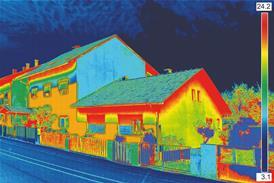The general methodology for presenting the appropriate documentation to a client has been to purchase copious quantities of binders and lever arch files, and fill them with photocopies of manufacturers' information and drawings.
Throw in a few materials schedules and the obligatory health and safety information and hey presto the project is completed, or so we would like to think.
For any project the emphasis has generally been to ensure the client's brief is delivered on time and to budget, all the appropriate regulations have been adhered to and all health and safety criteria have been covered. Every detail is considered and accommodated in pursuit of the definitive project. However, all this attention tends to wane once the project draws to a conclusion.
We are fortunate enough to have at our disposal a vast array of IT products that have been developed which allow engineers and contractors greater control, particularly over time and costs. We have programs that allow us to design systems, illustrate layouts or price schemes.
There are even complex products that provide us with a simulated operation of our designs. All of these programs are available to use from project inception through to handover, but these offer little comfort to the client once the keys have been issued.
As a profession, building services has probably the most complex of roles in both the design and operation of any project. Therefore it would appear that we are duty bound to ensure that the client receives sufficient information to allow them to operate and manage their assets as intended. Issuing files full of photocopies and manufacturers' literature is not satisfactory in the current climate of increased computerisation.
There are economic and environmental issues to consider. Regulations and obligations are placing evermore responsibility on both the client and engineer to ensure their operations are controlled and used both safely and economically. It is no longer sufficient to consider a project as being from its inception through to the end of the defects liability period; our responsibility goes further.
Clients are beginning to expect more, although they do not always know what more to expect. The current information issued on completion has been and still is varied in its quality and content, and soon becomes worthless. Paul Kenyon, regional director of FaberMaunsell Business Solutions, comments: "Hitherto, the information contained in building services o&m manuals has been too generic and non-project specific.
Other key information required to successfully operate and maintain complex building engineering systems is incomplete and the information provided is in a non user-friendly format."
But one thing that is certain is the information found within soon becomes worthless. Producing standardised documentation to issue to a client on practical completion has to be a starting point. This may require the support of new regulations outlining the characteristic of the information contained within.
If we as an industry are to offer our clients a professional service we must ensure the appropriate information is available to allow them to operate with the minimum of distraction.
Tom de Saulles, principal research engineer at BSRIA, adds: "We believe the traditional approach of compiling hard copy o&m manuals is, for many installations, an inadequate means of managing, presenting and updating information."
Taking this whole process a step further, there are a number of programs on the market that could offer a more effective way of ensuring that occupiers have the information they need, in a usable format. We can have asset management systems that focus on asset details and financial planning.
There are also planned preventative maintenance (ppm) packages, which offer details of how to maintain assets and control their operation.
But what is really needed is a method that covers both asset management and PPM and as such gives the end user greater control. There is no point having a ppm regime if you do not have budgetary support to accommodate it, inversely a budget is not sufficient if only used to 'fight fires' and is not used to reduce operating costs. So to roll all this information into one source must be the way forward.
Looking to the future
One possibility may be a product called System Asset Maintenance Manager (SAMM), which is an asset management software tool designed and produced by building services engineers.
The system aims to provide the client with a comprehensive database of all the assets they have within their organisation or property.
Each facility of this form allows specific details to be correlated for each component found into a concise format, which can be easily compiled by the project team and used by the client.
Paul Saddington, managing director of M&P Associates comments: "We are convinced that the use of versatile electronic databases such as SAMM is the future of operation and maintenance manuals, drawings and associated risk and methodology information.
Gone are the days of stacks of dust-covered manuals on shelves that only get opened to move offices. Here is the solution to allow one individual to manage multiple plant rooms, buildings and even sites with minimum effort."
The ability to store asset details and 'as fitted' drawings within the same database allows cross-referencing of assets and locations. Giving each asset its own unique code enables documents and information to be stored and quickly accessed.
There should not be any excuse from operatives that sufficient information was not at hand when working on or in a specific location. Risk assessments, method statements, COSHH data, isolation procedures, can always be accessed or new information can be added. Commissioning details and certificates can be logged and monitored to ensure that future inspections are kept up-to-date and meet current regulations.
All this flexibility gives rise to a more effective operation and planned maintenance regime than the standard documentation.
Complications caused by changes in staff are reduced due to the availability of the appropriate information in an easy to use format. If all the data associated with a particular asset can be found in one location then maintaining a live health and safety file for the future is considerably easier and is certainly attainable.
Considering this further, one of the biggest downfalls of the industry is future forecasting. We can try new techniques in design, we can even push the envelope of construction but what we tend to lack is the concentration to learn from the past.
Systems like SAMM could be used as learning tools when provided by the project team, forming an ongoing link with the client once they take occupation.
Both parties can plan future developments based on real performance feedback.
The use of IT systems to conclude projects in the manner suggested with samm allows engineers greater access to historical information.
If we provide the client with an easy to use system of operating and maintaining their project then there is an increased chance of the client following a procedure we condone.
Better maintenance gives rise to improved operations. Improved operations can lead to reductions in energy consumption and utility costs, which in turn allows the client to operate more effectively. With this in mind a continuing quality relationship between the client and their engineers can be fostered once the project has been complete .
The preparation and maintenance of a versatile database of this manner is ultimately cost-effective and beneficial to both parties.
The current method of compiling and concluding o&m information is not sufficient for the complexities of today's properties.
As building services engineers we are in a position to take the lead in advancing the industry to provide an improved service. We should not be waiting for clients to tell us whether they want better information. We must ensure each client gets that information from every source involved.
This must inevitably mean electronic packages that offer greater control, flexibility and assurance, with the possibility of substantial reductions in overheads.
Whether the client implements the regime we put forward is another concern but we as a profession will have issued sufficient information to operate their systems to the best of its capability.
We have met our obligation to the client and the industry and are in a position to improve the future for all.
SAMM – an overview of its components
- Offers the client detailed information of each asset.
- Allows maintenance procedures to be allocated to each asset.
- Enables the client to assess current and future cost expenditure.
- Provides life cycle cost analysis for assets.
- Allows fault reports or work orders to be produced, logged and analysed.
- Provides manufacturer and supplier details for each asset.
- Gives details of cost centres, systems, groups and locations.
- Allows drawings, operating and isolation information to be stored and viewed.
- Enables digital videos to be logged against each asset for training or operational guidance.
- Provides audit trails for each asset.
- Gives detailed reports on all aspects of data stored.
- Allows production and correlation of risk assessments, method statements and COSHH data for each asset.
- Features multi level security access.
- Allows compilation of energy consumption data for continued analysis.
Source
Building Sustainable Design
Postscript
Jonathan Oldknow CEng MCIBSE is managing director of MPL Construction.




















No comments yet